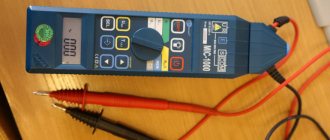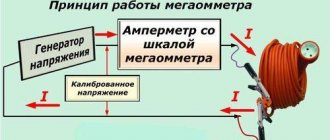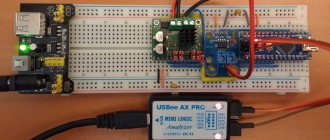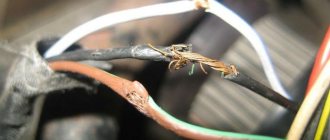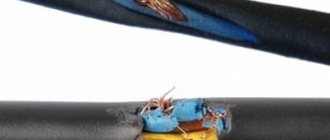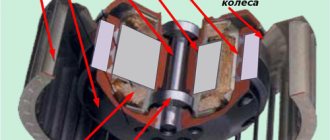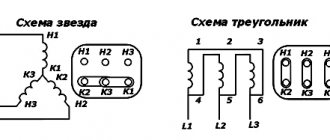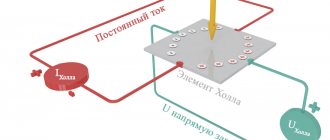What acts as an artificial grounding conductor
The grounding element is made in the form of a conductor (electrode) of a certain material, which is placed in the ground.
In some cases, several similar grounding conductors are installed. Determining the situation when it is necessary to install a group of artificial rods is realized through special calculations. The result of the calculation justifies the choice of electrode configuration in relation to its resistance - the main indicator that determines the quality of grounding.
An artificial ground electrode is made from the following materials:
- Copper-plated steel. The connection between copper and steel has good adhesion. The rods are durable and have excellent contact with any materials. Due to its chemical properties, the alloy has excellent electrical conductivity. The electrochemical activity of copper and steel is insignificant; normal operation of ground electrodes made of such metal can reach more than a hundred years.
- Cink Steel. Advantages: corrosion resistance of the material, low resistance, electrodes are resistant to acidic environments.
- Black metals. Disadvantage: rapid destruction in aggressive soil (corrosion and rust form). The high strength of the material increases the resistance to current spreading, which is extremely dangerous for humans.
In addition to the material, artificial ground electrodes differ in shape and location in the soil (deep vertical and extended horizontal type).
DIY grounding installation
The location is chosen so that there are no communications on the site. Before making grounding at the dacha with your own hands, coordinate the scheme with the water supply, gas service and other offices. Grounding is done more often on the north side of the house, since there is always a more humid place on the site.
Mount the circuit according to the rules:
- dig a trench for horizontal connections;
- pins are hammered into the corners of a triangle with equal sides;
- You cannot dig holes for the rods; the rods must fit tightly into the ground;
- weld the strip to the corners, attach a conductive cable going to the building;
- After joining, welding areas are treated with melted bitumen (resin);
- bury the installation site.
Check grounding using a multimeter. The socket is opened in the house, the device is switched to voltage regulation. After connecting the zero and phase probes, the multimeter should show voltage. Then the phase and ground are connected, and the voltage should drop slightly.
Electrical ground connection
A circuit with several grounds connected electrically ensures that different, sometimes conflicting, requirements for grounding devices are met. According to the PUE, grounding, like many other metal elements of the building, as well as equipment installed in it, must be connected by a potential equalization system. Potential equalization refers to the electrical connection of conductive parts to achieve equal potential. There are main and additional potential equalization systems. Grounding connections are connected to the main potential equalization system, that is, they are connected to each other through the main grounding bus. The wires connecting the grounding to this bus must be connected according to the radial principle, that is, one branch from the specified bus goes to only one ground.
In order to ensure safe operation of the entire system, it is very important to use the most reliable connection between the grounding and the main grounding bus, which will not be destroyed by lightning. To do this, you need to comply with the standards of PUE and GOST R 50571.5.54-2013 “Low-voltage electrical installations. Part 5-54. Grounding devices, protective conductors and protective potential equalization conductors” regarding the cross-section of the potential equalization system wires and their connections to each other.
However, even a very high-quality potential equalization system cannot guarantee the absence of voltage surges in the network when lightning strikes a building. Therefore, along with well-designed grounding loops, surge noise protection devices (SPDs) will save you from problems. Such protection is multi-stage and selective in nature. That is, a set of surge protection devices must be installed at the facility, the selection of elements of which is not an easy task even for an experienced specialist. Fortunately, ready-made SPD kits are available for typical applications.
PUE REQUIREMENTS FOR THE ARRANGEMENT AND QUALITY OF GROUNDING
To implement such protection against electric shock, it is necessary to ensure reliable contact of the electrical installation housing with the ground.
In its presence, a current charge dangerous to humans flows into the ground through a grounding device, the resistance of which is significantly lower than that of the human body.
TYPES OF GROUNDING DEVICES
According to the requirements of the PUE, electrical equipment enclosures must be grounded to ensure safety. For this purpose, various types of grounding conductors are used.
The following can be used as ready-made ones:
- metal structures laid in the ground and in direct contact with it;
- metal casings and sheaths of cables laid in the ground for specific purposes;
- metal pipelines (except for gas communications and oil pipelines);
- railway rails.
The use of ready-made structures as grounding conductors significantly simplifies and reduces the cost of arranging the entire system.
Specially mounted grounding devices are used when it is not possible to use underground pipes, cable communications or metal structural elements.
They are various structural elements placed in the ground at a certain depth and ensuring reliable contact with the soil.
The simplest version of such a ground electrode is a steel rod at least 2.5 meters long. After it is buried, a thick copper conductor (steel strip) is attached to the tip and connected to the grounding system.
GROUNDING RESISTANCE
The main requirement for a grounding device, regardless of its type, is to provide conditions for the flow of charges dangerous to humans into the soil. Its functionality is assessed by its spreading resistance (the lower it is, the more effective the grounding is).
The main components are resistances:
- the ground electrode itself;
- transitional (contact) between the ground electrode and the ground;
- soil at the point of contact with the grounding device.
According to the PUE, the resistance of a typical device installed on the consumer side should not exceed 30 Ohms. Under special operating conditions of equipment (at power substations, in particular), it is standardized at a level of no more than 4 ohms.
It is possible to achieve standardized indicators by taking special measures. As a rule, they come down to the following techniques:
- increasing the contact area of artificial grounding elements with the ground;
- improving soil conductivity (by moistening or adding chemicals).
In addition, the requirements of the PUE require periodic measurements of grounding resistance for compliance with current standards.
* * *
2014-2021 All rights reserved. The materials on the site are for informational purposes only, may express the opinion of the author and are not to be used as guidelines or normative documents.
One common or separate grounding devices?
Grounding conductors for electrical installations and lightning protection have different requirements, and this circumstance can cause some problems. A ground electrode for lightning protection must discharge a large electric charge into the ground in a short time. At the same time, according to the “Lightning Protection Instructions RD 34.21.122-87”, the design of the ground electrode is standardized. For a lightning rod, according to this instruction, at least two vertical, or radial horizontal, grounding conductors are required, with the exception of category 1 of lightning protection, when three such pins are needed. That is why the most common grounding option for a lightning rod is two or three pins, each about 3 m long, connected by a metal strip buried at least 50 cm into the ground. When using parts produced by ZANDZ, such a ground electrode is durable and easy to install.
Grounding for electrical installations is a completely different matter. In a normal case, it should not exceed 30 Ohms, and for a number of applications described in departmental instructions, for example, for cellular communication equipment - 4 Ohms or even less. Such grounding electrodes are pins more than 10 m long or even metal plates placed at great depths (up to 40 m), where the soil does not freeze even in winter. It is too expensive to create such a lightning rod with two or more elements buried at tens of meters.
If the soil parameters and resistance requirements allow for a single grounding in the building for lightning rods and grounding of electrical installations, there are no obstacles to doing it. In other cases, various grounding loops are made for the lightning rod and electrical installations, but they must be connected electrically, preferably in the ground. The exception is the use of some special equipment that is particularly sensitive to interference. For example, sound recording equipment. Such equipment requires a separate, so-called technological grounding device, which is directly indicated in the instructions. In this case, a separate grounding device is made, which is connected to the building's potential equalization system through the main grounding bus. And, if such a connection is not provided for in the equipment operating manual, then special measures are taken to prevent people from simultaneously touching the specified equipment and metal parts of the building.
Design features
As mentioned above, the basic design element is the grounding rods. Their number, material, diameter and length depend on the installation conditions and the soil resistivity to current spreading. The higher the resistance, the greater the total length and/or diameter, the greater the number of installation points for grounding electrodes.
The rods have threads at the ends and are connected to each other by means of couplings. At the same time, to ensure better conductivity in the places where they are installed, the constructs are lubricated with conductive lubricant (paste).
Foreign manufacturers use a trunnion-type couplingless connection; it is more contact and does not need to be lubricated with paste. That is, a self-closing structure is obtained (the example below shows a cut at the junction).
To facilitate installation in the ground, the kits include tips and impact heads. Manufacturers from Russia make these components with threads, while foreign ones eliminate the risks arising from threaded contact, especially when hammering, and connect the elements securely into a joint.
At the point where the last (upper) grounding conductor exits, the entire structure is connected using a clamp to a lightning protection system or grounding bus
The geometry of the clamp does not matter (diagonal or cross), it is only important that its material, in terms of corrosion, does not “conflict” with the material of the grounding conductors and grounding conductors
One common or separate grounding devices?
Grounding conductors for electrical installations and lightning protection have different requirements, and this circumstance can cause some problems. A ground electrode for lightning protection must discharge a large electric charge into the ground in a short time. At the same time, according to the “Lightning Protection Instructions RD 34.21.122-87”, the design of the ground electrode is standardized. For a lightning rod, according to this instruction, at least two vertical, or radial horizontal, grounding conductors are required, with the exception of category 1 of lightning protection, when three such pins are needed. That is why the most common grounding option for a lightning rod is two or three pins, each about 3 m long, connected by a metal strip buried at least 50 cm into the ground. When using parts produced by ZANDZ, such a ground electrode is durable and easy to install.
Grounding for electrical installations is a completely different matter. In a normal case, it should not exceed 30 Ohms, and for a number of applications described in departmental instructions, for example, for cellular communication equipment - 4 Ohms or even less. Such grounding electrodes are pins more than 10 m long or even metal plates placed at great depths (up to 40 m), where the soil does not freeze even in winter. It is too expensive to create such a lightning rod with two or more elements buried at tens of meters.
If the soil parameters and resistance requirements allow for a single grounding in the building for lightning rods and grounding of electrical installations, there are no obstacles to doing it. In other cases, various grounding loops are made for the lightning rod and electrical installations, but they must be connected electrically, preferably in the ground. The exception is the use of some special equipment that is particularly sensitive to interference. For example, sound recording equipment. Such equipment requires a separate, so-called technological grounding device, which is directly indicated in the instructions. In this case, a separate grounding device is made, which is connected to the building's potential equalization system through the main grounding bus. And, if such a connection is not provided for in the equipment operating manual, then special measures are taken to prevent people from simultaneously touching the specified equipment and metal parts of the building.
Grounding Requirements
After you have figured out what is the definition of the very concept of grounding, you can move on to those categories and norms that are introduced by current standards. According to the PUE, the grounding device is primarily subject to the following requirements:
- the purpose of the charger is to effectively drain dangerous currents into the ground, for which purpose their design includes a whole set of conductors and metal rods;
- All parts of the electrical installation, including metal switchboard doors, must be grounded;
- the total contact resistance of the contacts in the grounding system should not exceed 4-30 Ohms;
- when installing it in distributed loads, it is necessary to use a potential equalization system (its purpose is to eliminate uneven voltage distribution).
Additional information: Since the main purpose of grounding is to ensure the safety of personnel working with the equipment, during its operation special attention is paid to the reliability of operation. The quality of its work is ensured by a whole range of preventive measures and periodically organized tests.
Grounding and grounding.
Electrical ground connection
A circuit with several grounds connected electrically ensures that different, sometimes conflicting, requirements for grounding devices are met. According to the PUE, grounding, like many other metal elements of the building, as well as equipment installed in it, must be connected by a potential equalization system. Potential equalization refers to the electrical connection of conductive parts to achieve equal potential. There are main and additional potential equalization systems. Grounding connections are connected to the main potential equalization system, that is, they are connected to each other through the main grounding bus. The wires connecting the grounding to this bus must be connected according to the radial principle, that is, one branch from the specified bus goes to only one ground.
In order to ensure safe operation of the entire system, it is very important to use the most reliable connection between the grounding and the main grounding bus, which will not be destroyed by lightning. To do this, you need to comply with the standards of PUE and GOST R 50571.5.54-2013 “Low-voltage electrical installations. Part 5-54. Grounding devices, protective conductors and protective potential equalization conductors” regarding the cross-section of the potential equalization system wires and their connections to each other.
However, even a very high-quality potential equalization system cannot guarantee the absence of voltage surges in the network when lightning strikes a building. Therefore, along with well-designed grounding loops, surge noise protection devices (SPDs) will save you from problems. Such protection is multi-stage and selective in nature. That is, a set of surge protection devices must be installed at the facility, the selection of elements of which is not an easy task even for an experienced specialist. Fortunately, ready-made SPD kits are available for typical applications.
Types of designs
Using incorrectly connected electrical appliances can be unsafe. The danger is that during use a breakdown may occur, as a result of which the voltage will transfer to the device body. This voltage can either damage the device itself or cause electrical injury of varying severity to a person (including death). To prevent such problems, two types of grounding can be used:
- Natural. This includes massive structures that are permanently in the ground. The role of natural grounding conductors is given to the foundations of buildings, water pipes, metal structures and sheet piles, well fixed in the ground. The advantage of such structures is that providing grounding with their help does not require additional costs. However, natural loop resistance cannot be calculated.
- Artificial. Grounding of this kind is created specifically from horizontal and vertical elements (electrodes) made of a certain material and having a specific size. The main elements of the artificial contour are most often steel parts that have a round or angular shape. The quality of such grounding depends on the resistance possessed by artificial ground electrodes. The resistance of each electrode is determined using a special formula.
All modern devices powered by electricity are grounded. All that needs to be done is simply to provide a connection to the main grounding system.
Section of grounding electrodes
To ensure reliable and long-term operation of grounding electrodes in terms of corrosion and mechanical resistance, minimum dimensions of grounding electrodes are adopted.
Copper
| Profile | Cross-sectional area, mm² | Diameter, mm | Thickness, mm |
| Rectangular | 50 | 2 | |
| Round wire (immersion depth < 0.5 m) | 25 | ||
| Cable | 25 | 1.8 for each wire | |
| Pipe | 20 | 2 |
Copper-plated steel (electrolytic deposition)
| Profile | Diameter, mm | Coating thickness, microns |
| Round rod | 14 | 100 |
"Black" steel (uncoated)
| Profile | Cross-sectional area, mm² | Diameter, mm | Thickness, mm |
| Rectangular | 150 | 5 | |
| Angular | 150 | 5 | |
| Round rod | 18 | ||
| Pipe | 32 | 3,5 |
Stainless steel
| Profile | Cross-sectional area, mm² | Diameter, mm | Thickness, mm |
| Rectangular | 90 | 3 | |
| Angular | 90 | 3 | |
| Round rod | 16 | ||
| Pipe | 25 | 2 |
Cink Steel
| Profile | Section area, mm² | Diameter, mm | Thickness, mm | Coating thickness, microns |
| Rectangular | 90 | 3 | 70 | |
| Angular | 90 | 3 | 70 | |
| Round rod | 16 | 70 | ||
| Pipe | 25 | 2 | 55 |
The need to electrically connect the grounding loop of lightning protection installed directly on the building with the grounding loop for electrical installations is prescribed in the current regulatory documents (PUE). We quote verbatim: “Grounding devices for protective grounding of electrical installations of buildings and structures and lightning protection of categories 2 and 3 of these buildings and structures, as a rule, should be common.” The 2nd and 3rd categories are the most common; the 1st category includes explosive objects for which increased lightning protection requirements are imposed. However, the presence of the phrase “as a rule” implies the possibility of exceptions.
Modern office and now residential buildings contain many life support engineering systems. It is difficult to imagine the absence of ventilation systems, fire extinguishing systems, video surveillance, access control, etc. Naturally, the designers of such systems have concerns that “delicate” electronics will fail as a result of lightning. At the same time, some doubts arise among practitioners about the feasibility of connecting the contours of two types of grounding and a desire arises “within the limits of the law” to design electrically unconnected groundings. Is this approach possible and will it actually improve the safety of electronic devices?
What are the requirements for artificial grounding conductors?
Artificial grounding conductors cannot be painted, since painting acts as an insulator and prevents the discharge of electric current into the ground. Thus, the color of the grounding conductor should be the natural color of the metal used in grounding devices. But the connection points of the conductors (welding seams) must be painted with bitumen paint to prevent destruction.
You cannot place artificial or use natural grounding electrodes near heat sources that dry out the earth. For arid areas there is a special reinforced concrete structure. The ground electrode is made in the form of a container and placed below the surface of the earth. The container is filled with water through the hatch. Thus, the water distribution system takes part in grounding. Steel electrodes are connected to the outlet from the container. This ensures optimal resistance.
To create artificial grounding conductors, the following materials with the specified parameters are used:
- the diameter of the steel reinforcing bar is at least 10 mm;
- the diameter of the galvanized rod is at least 6 mm;
- in the corners the wall thickness is from 4 mm;
- when using strip steel, its thickness must be at least 4 mm;
- in lightning protection grounding conductors, the cross-section is taken from 155 mm2;
- The wall thickness of rejected pipes is at least 3.5 mm.
Only for temporary electrical installations can electrodes with minimum values be used. In order for the grounding device to serve for 40-50 years in favorable soil conditions, it is enough to select rods for it that are 2-3 mm larger. In wet soils, the thickness and diameters of the pads should be 2 times higher than the minimum.
Of all the mentioned materials, the use of round reinforcement is considered the most optimal, since the metal consumption in this case is reduced by 1.5 times, and the cost of grounding devices is correspondingly reduced.
The corrosion resistance of round steel is higher than that of linear steel, because the round electrode has the smallest contact area with the ground compared to other forms of electrode. Another advantage is that round rod electrodes are easier to install, saving time spent on charging devices.
When grounding powerful high-voltage installations, circuits are used consisting of horizontal beams extending over hundreds of meters and several dozen vertically installed rods. To prevent artificial ground electrodes from shielding each other, the beams are spread horizontally in opposite directions. If there are 3 or 4 rays, they are placed at an angle of 90 and 120 degrees, respectively.
Artificial grounding: types, functions, requirements and installation
Metal structures specially made for grounding circuits are characterized as an artificial grounding conductor. This type of electrodes is used in the following cases:
- impossibility of using natural grounding elements;
- excess current indicators of permissible loads on the natural ground electrode.
Such a structural grounding element has a certain configuration (material, number of elements, length, location of electrodes).
Functions of an artificial grounding element
According to clause PUE 1.7.28, grounding must be organized for all types of industrial and household electrical installations. The need for installation is justified by the practical significance of the system’s functions. Each part of the grounding device has its own task.
The conductive element or a set of interconnected similar elements of the grounding device play an important role in the proper operation of the entire grounding system of the facility.
There are two main functions of grounding, which are implemented using an artificial ground electrode:
- Ensuring electrical safety for users of electrical installations. The main tasks of the protective function are to reduce the potential difference and remove stray current. Leakage current is formed when the grounding object interacts with the phase cable.
- Supports the efficient and uninterrupted operation of both electrical equipment and the entire electrical installation.
Important! Grounding is more effective when the facility's electrical system is equipped with a residual current device (RCD) or similar protective devices. Such devices immediately respond to current leakage.
An artificial grounding system has a number of requirements, the implementation of which will allow achieving the proper result of performing its functions. The basis is reliable installation and optimal location of the grounding element in the ground.
During the manufacturing process, the artificial grounding conductor is repeatedly tested for compliance with all parameters of regulatory requirements. The situation is similar with its installation and location in the ground. Summarizing the data, we can highlight the main points of the production of such electrical installation:
- The installation process is almost completely mechanized.
- If two extended (horizontal) beams are provided, the electrodes are laid from the grounded part of the electrical installation in opposite directions. Provided that there are more than two ground electrodes, the beams are laid at an angle (angle 120° - 90°). This placement is due to the improvement in the resistance indicator.
- When installing a ground electrode, potential distribution often occurs. The difference in potential on the surface of the soil (above the ground electrode) and around the element (inside the soil) causes dangerous voltages to arise. To equalize potentials in such cases, an artificial ground electrode is made in the form of a grid. Horizontal electrodes are laid both along and across the electrical installation area. Connections at intersections are made by welding.
Important! When electrodes of this type are placed close together, shielding occurs. Their effectiveness rate decreases.
The final stage of grounding will necessarily be the work of measuring grounding resistance parameters.
How to determine resistance
According to regulatory documentation, this indicator is considered the main one for determining the quality of the grounding device. Resistance regulates the reliability of production of the main functions of grounding elements.
Factors that have a primary influence on the indicator:
- Area (S) of grounding electrodes with soil (“draining” of current).
- Electrical resistivity of soil (R).
There are standard indicators of spreading resistance, which ensure the effective operation of the grounding system. The level of current conductivity by the device is determined.
Note! For an electrical installation with a voltage of 380 V, the resistance value should not exceed 30 Ohms. Video surveillance systems, server units and medical equipment are grounded with a resistance of the grounding elements of 0.5–1 Ohm.
Determining such a conductivity indicator is not a single recommendation. There are also a number of generally mandatory requirements for the structure and installation of such a grounding element.
Primary requirements
Most of the relevant recommendations and rules regulate the design and placement of such a component of the grounding system. Requirements that an artificial grounding system must meet:
- For arid areas, there is a separate technology for grounding using reinforced concrete structures.
- The artificial grounding conductor cannot be painted. This is explained by the fact that any coloring acts as an insulator. The insulation will prevent current from flowing into the soil. The artificial grounding conductor must have a natural color.
- Welding seams (conductor connections) must be painted. Painted with bitumen paint, premature destruction of the connecting elements is prevented.
- Non-standard (reduced) electrode values are used exclusively when installing temporary electrical installations.
The optimal choice of grounding material is considered to be round reinforcement. Justification for this priority:
- Minimum metal consumption. Consequently, the cost of the grounding device is reduced.
- The corrosion resistance of such an electrode is significantly higher than that of its analogues.
- Ease of installation.
In addition to the profile requirements, there is a recommended standardization of the parameters (dimensions) of the material used to create an artificial grounding element.
Deepening the electrodes
The electrodes are driven into the ground by driving them with a sledgehammer. To make work easier, it is better to use a scaffold or stepladder. If the metal of the electrodes is too soft, then the blows are delivered through special wooden bars. There is no need to drive the pins in completely: about 10-20 centimeters should remain above the ground, which are used to connect to the circuit.
The factory electrodes are driven in with a jackhammer. After the pin is deepened, a coupling and an additional grounding conductor are screwed onto it. The process is repeated several times until the required depth is achieved.
Types of grounding
In the classification of types of grounding there are two main types:
- Working.
- Protective.
There are several subgroups: radio grounding, measuring, instrumental, control.
Working
There is a certain category of electrical installations that will not work unless they are grounded. That is, the main purpose of constructing a grounding system is not to ensure operational safety, but to ensure the operation itself. Therefore, in this article we will not be interested in this species.
Protective
But this type is specially arranged to ensure the safety of electrical installations. It is divided into three categories depending on its purpose:
- Lightning protection.
- Protection against surge voltage (overload of current consumption line or short circuit).
- Protection of the electrical network from electromagnetic interference (most often this type of interference is generated from nearby operating electrical equipment).
We are interested in pulse overvoltage. The purpose of this type of grounding is the safety of operating personnel and the installation itself in the event of an accident or equipment breakdown. Typically, such a breakdown inside an electrical unit is a short circuit of the electrical circuit wire to the device body. The short circuit can occur directly or through any other conductor, for example, through water. A person who touches the installation body is exposed to electric current, because he becomes its conductor into the ground. In fact, it itself becomes part of the ground loop.
Grounding diagram in a private house
That is why, in order to eliminate such situations, the housing is grounded to a circuit located in the ground. At the same time, the activation of the grounding circuit is an impetus for the system of automatic machines, which immediately turn off the power supply to the equipment. All this is located in special power and distribution boards.
Ground resistance
There is such a term as resistance to current flow. For ordinary people it will be easier to perceive it as resistance to grounding. The whole point of this term is that the grounding circuit must work correctly within certain parameters. So resistance is the main one.
The optimal option for this value is zero. That is, it is best to use materials for assembling the circuit that have the highest electrical conductivity. Of course, there is no way to achieve the ideal, so try to choose those with the lowest resistance. These include all metals.
There are special coefficients that are used to determine the resistance of a grounding loop operated under different conditions. Eg:
in private housing construction, where networks of 220 and 380 volts (6 and 10 kV) are used, it is necessary to install a circuit with a resistance of 30 Ohms.
- the installed gas pipeline system entering the house must be grounded with a 10 ohm circuit.
- lightning protection must have a resistance of no more than 10 ohms.
- Telecommunications equipment is grounded using a 2 or 4 ohm loop.
- Substations from 10 kV to 110 kV – 0.5 Ohm.
That is, it turns out that the greater the current power inside the equipment or devices, the lower the resistance should be.
Why is it necessary to combine ground loops?
When lightning strikes a lightning rod, a short electrical impulse with a voltage of up to hundreds of kilovolts occurs in the latter. At such a high voltage, a breakdown of the gap between the lightning rod and the metal structures of the house, including electrical cables, may occur. The consequence of this will be the emergence of uncontrolled currents, which can lead to fire, failure of electronics and even destruction of infrastructure elements (for example, plastic water pipes). Experienced electricians say: “Give lightning a way, otherwise it will find it on its own.” This is why electrical grounding is mandatory.
For the same reason, the PUE recommends electrically combining not only the groundings located in the same building, but also the groundings of geographically close objects. This concept refers to objects whose groundings are so close that there is no zone of zero potential between them. The combination of several groundings into one is carried out, in accordance with the standards of PUE-7, clause 1.7.55, by connecting the grounding conductors with electrical conductors in the amount of at least two pieces. Moreover, conductors can be either natural (for example, metal elements of a building’s structure) or artificial (wires, rigid busbars, etc.).
What is a ground electrode and what can be used as a ground electrode?
What is a ground electrode?
GROUNDING LEADER - a conductive part (or a set of interconnected conductive parts) that is in contact with the ground directly or through an intermediate conductive medium.
What can a grounding conductor be made from?
1.7.109. The following can be used as natural ground electrodes: 1) metal and reinforced concrete structures of buildings and structures in contact with the ground, including reinforced concrete foundations of buildings and structures that have protective waterproofing coatings in non-aggressive, slightly aggressive and moderately aggressive environments; 2) metal water pipes laid in the ground; 3) casing pipes of boreholes; 4) metal sheet piles of hydraulic structures, water conduits, embedded parts of valves, etc.; 5) rail tracks of main non-electrified railways and access roads if there is a deliberate arrangement of jumpers between the rails; 6) other metal structures and structures located in the ground; 7) metal shells of armored cables laid in the ground. Cable sheaths can serve as the only grounding conductors when there are at least two cables. Aluminum cable sheaths are not allowed to be used as grounding conductors.
What cannot be used as a grounding conductor?
1.7.110. It is not allowed to use pipelines of flammable liquids, flammable or explosive gases and mixtures, and sewerage and central heating pipelines as grounding conductors. The specified restrictions do not exclude the need to connect such pipelines to a grounding device for the purpose of equalizing potentials in accordance with 1.7.82. Reinforced concrete structures of buildings and structures with prestressed reinforcement should not be used as grounding conductors, however, this restriction does not apply to overhead line supports and outdoor switchgear support structures. The possibility of using natural grounding conductors based on the density of currents flowing through them, the need to weld reinforcing bars of reinforced concrete foundations and structures, welding anchor bolts of steel columns to reinforcing bars of reinforced concrete foundations, as well as the possibility of using foundations in highly aggressive environments must be determined by calculation.
Requirements for artificial grounding conductors?
1.7.111. Artificial grounding conductors can be made of black or galvanized steel or copper. Artificial grounding conductors should not be painted. 1.7.112. The cross-section of horizontal grounding conductors for electrical installations with voltages above 1 kV should be selected according to the condition of thermal resistance at a permissible heating temperature of 400 °C (short-term heating corresponding to the duration of the protection and tripping of the circuit breaker). In case of danger of corrosion of grounding devices, one of the following measures should be taken: increase the cross-sections of grounding conductors and grounding conductors, taking into account their estimated service life; use galvanized or copper grounding conductors and grounding conductors. In this case, one should take into account the possible increase in the resistance of grounding devices due to corrosion. Trenches for horizontal grounding conductors must be filled with homogeneous soil that does not contain crushed stone and construction waste. Grounding electrodes should not be located (used) in places where the ground is dried out by the heat of pipelines, etc.
Why is it necessary to combine ground loops?
When lightning strikes a lightning rod, a short electrical impulse with a voltage of up to hundreds of kilovolts occurs in the latter. At such a high voltage, a breakdown of the gap between the lightning rod and the metal structures of the house, including electrical cables, may occur. The consequence of this will be the emergence of uncontrolled currents, which can lead to fire, failure of electronics and even destruction of infrastructure elements (for example, plastic water pipes). Experienced electricians say: “Give lightning a way, otherwise it will find it on its own.” This is why electrical grounding is mandatory.
For the same reason, the PUE recommends electrically combining not only the groundings located in the same building, but also the groundings of geographically close objects. This concept refers to objects whose groundings are so close that there is no zone of zero potential between them. The combination of several groundings into one is carried out, in accordance with the standards of PUE-7, clause 1.7.55, by connecting the grounding conductors with electrical conductors in the amount of at least two pieces. Moreover, conductors can be either natural (for example, metal elements of a building’s structure) or artificial (wires, rigid busbars, etc.).
What acts as an artificial grounding conductor
The grounding element is made in the form of a conductor (electrode) of a certain material, which is placed in the ground. In some cases, several similar grounding conductors are installed.
Determining the situation when it is necessary to install a group of artificial rods is realized through special calculations. The result of the calculation justifies the choice of electrode configuration in relation to its resistance - the main indicator that determines the quality of grounding.
An artificial ground electrode is made from the following materials:
- Copper-plated steel. The connection between copper and steel has good adhesion. The rods are durable and have excellent contact with any materials. Due to its chemical properties, the alloy has excellent electrical conductivity. The electrochemical activity of copper and steel is insignificant; normal operation of ground electrodes made of such metal can reach more than a hundred years.
- Cink Steel. Advantages: corrosion resistance of the material, low resistance, electrodes are resistant to acidic environments.
- Black metals. Disadvantage: rapid destruction in aggressive soil (corrosion and rust form). The high strength of the material increases the resistance to current spreading, which is extremely dangerous for humans.
In addition to the material, artificial ground electrodes differ in shape and location in the soil (deep vertical and extended horizontal type).
Electrode placement
The parts included in the general grounding structure can be located vertically or horizontally. In the first installation method, the electrodes are buried 70 cm into the ground. However, their length should not exceed 5 m, and their diameter should be in the range of 10-16 mm.
The horizontal laying method involves deepening the grounding bars by 50 cm (in the case of arable land by 1 m). Horizontally located steel rods with a diameter of more than 1 cm (or steel strips with a thickness of more than 4 mm) are used to connect vertically installed elements, the joints between them are fixed by welding. This method shows its effectiveness only if there is sufficient electrical conductivity of the top layer of soil.
Electrical installation rules require grounding for electrical equipment for domestic and industrial purposes. There are no clear requirements regarding how the electrodes should be located in the ground. In each specific case this is determined individually.
You might be interested in: Types of single-pole and double-pole voltage indicators up to 1000 V
Electrical safety created with the help of artificial grounding conductors is realized by reducing the potential difference and removing stray current. Leakage current occurs due to the interaction of the grounding element and the phase cable. At the same time, uninterrupted and efficient functioning of electrical equipment is ensured.
Location in the ground
Artificial grounding is used where it is not possible to use natural grounding, or when the current loads on natural grounding conductors exceed permissible limits. Artificial grounding devices are made of steel structures, but if the soil is too acidic, or, on the contrary, it is susceptible to alkalization, grounding devices made of copper or galvanized metal are used.
The shape and structure of the artificial ground electrode is similar to a classic electrode. More often, this is a rod made of a steel strip or a round rod. Based on the type of location, there are 2 main types of memory. In the horizontal type, grounding conductors are laid along the perimeter of the foundation at the bottom of the trench.
Vertical grounding conductors are made from rods with a diameter of 12-15 mm and a length of up to 4-5 meters. They are driven into the ground to a depth of 0.5-0.7 m.
The placement of artificial grounding conductors at a certain angle is allowed, and then the concepts of vertical or horizontal become conditional.
An inclined arrangement is used if the wall of the building is located at an angle to the vertical. Tilt does not significantly affect the functions of the device.
In grounding electrical installations with high voltage, so-called complex grounding conductors are used, in which vertical elements are connected to horizontal ones.
When the device of artificial ground electrodes is placed on arable land, all electrodes must be placed at a depth of at least 1 meter. This allows for increased contact with the ground.
